South London Hospital
for Women and Children
103 South Side, Clapham Common, SW4 9DR
Medical dates:
Medical character:
1912 - 1984
General
The perceived need for a general hospital for women in south London, staffed totally by women, was met when the South London Hospital for Women was founded by Miss Eleanor Davies-Colley (1874-1934) and Miss Maud Chadburn (1868-1957) in 1912. The new hospital would also train women doctors to become specialists (most hospitals at this time refused to employ them).
The two women, both surgeons at the New Hospital for Women, had begun raising funds in 1911. The New Hospital for Women, which had been established for the same purposes, was having to turn away patients as it was unable to cope with the demand.
In September 1911 the freehold of two large houses - Holland House and Kingston House - on the south side of Clapham Common had been purchased for £5,000 following a public appeal. Kingston House was occupied by Cecil Hook, Bishop of Kingston, (which brought in rent) but Holland House was empty.
An anonymous donation of £53,000 towards the building costs and a further £40,000 for the endowment of the Hospital enabled it to open within a year of its foundation, in August 1912. It had 20 beds. The building was large enough to also provide staff accommodation.
The Out-Patients Department opened in 1913 at 88 and 90 Newington Causeway.
On 1st July 1913, Princess Louise laid the foundation stone for a new Hospital building. At the end of 1914, arrangements were made with a nearby nursing home for in-patients to be temporarily accommodated in a large room with 4 beds while Holland House was demolished and building work could continue. However, a dispute in the building trade delayed completion.
The South London Hospital for Women was officially opened by Queen Mary on 4th July 1916. With 80 beds, it was the largest in the world to be staffed almost entirely by women; only women and children (males under the age of 6 years) were admitted.
It was said to be an 'Adamless Eden' as, apart from the engineer and the gardener, all the staff were women, including the porters. A state-of-the art building, each ward had a balcony and an unusually large bathroom, which had wide doors so that a patient could be helped to enter supported by two nurses. The lavatory walls were covered with white marble, as this was believed to be non-absorbent. An electric lift could take patients on their beds up to the flat roof for open-air treatment. The infectious wards could only be entered from the flat roof. The nurses quarters contained a dining room, sitting room, silent room and visitors' room. Each nurse had her own bedroom. Their bathrooms contained facilities for shampooing hair and hot rails over which it could be dried. The ward maids and servants had their own comfortably fitted cubicles in the basement.
In 1920 another building - Preston House - on the south side of the Hospital site was purchased (£12,000 had been given by an anonymous donor). This was equipped to provide an extra 40 surgical beds and was opened by the Duchess of York in 1924.
In 1926 it had been decided that it would be more economical to have the Out-Patients Department on the same site. Kingston House, on the north side of the Hospital, was demolished in 1927 and a new North Wing built. This included a new Out-Patients Department, 16 private patient cubicles and a general ward with 10 beds.
The North Wing opened in 1929 and building works continued throughout the 1930s. In 1932 a new X-ray Department opened. In 1934 the Hospital had 140 beds. In 1936 a modern operating theatre was installed and the kitchen enlarged.
The name of the Hospital was changed slightly and it became the South London Hospital for Women and Children (although boys up to the age of six had always been admitted).
In 1937 work began on a new South Wing, which would contain a Department of Pathology, 2 wards, private patients rooms and a children's ward on the top floor. A Nurses Home was also to be built.
The outbreak of WW2 in 1939 postponed the official opening of the new South Wing and Nurses' Home.
The Hospital joined the Emergency Medical Service (EMS) and, after a Special Act of Parliament enabled it to treat male patients of any age, admitted war casualties. The Out-Patients waiting hall became a Casualty Receiving Ward and the surrounding rooms were converted into wards and operating theatres.
Under the EMS, the Hospital used beds at the Schiff Home and once a week an operating session was held there.
In 1940 a chapel opened in the basement of Preston House.
Apart from the Nurses' Home, which received a direct hit in March 1941, the buildings did not suffer serious damage but, like other hospitals at this time, normal work was disrupted due to shortage of staff. A 20-bed maternity unit had been due to open in 1944, but because of the danger of V1 flying bombs, it was evacuated to Scarborough. This proved too small and the maternity home returned to London and opened a few months later in Nightingale Lane (and was officially opened only in 1948 as the Queen Elizabeth Maternity Home).
A house in Chistlehurst was loaned to the Hospital; it had 35 beds for patients receiving medical treatment or convalescing following surgery.
In 1945 the Nurses' Home was finally able to fully open.
In 1948 the Hospital joined the NHS under the control of the Lambeth Group Hospital Management Committee, part of the South West Metropolitan Regional Hospital Board. It had 250 beds. In the same year Woodhurst, a house at Pease Pottage near Crawley , was purchased and opened as a country annexe (it closed in 1970).
In October 1958 a plaque dedicated to Miss Chadburn, one of the founders of the Hospital who had died in 1957, was placed in the entrance hall.
In 1963 the chapel in Preston House was replaced with a prefabricated hut. It was dedicated on 27th June by the Bishop of Southwark.
In 1964, following an NHS reorganisation, the Hospital passed to the newly formed South West London Group Hospital Management Committee. It had 263 beds.
In 1974, following a major reorganisation of the NHS, it became part of the Wandsworth and East Merton (Teaching) District Health Authority, part of the South West Thames Regional Health Authority.
In 1982, after yet another NHS reorganisation, the Wandsworth District Health Authority assumed responsibility for the Hospital. The Health Authority decided it was 'uneconomic' and, despite strong public opposition, a petition signed by 60,000 people and occupation of the building for nine months by protesters, the Hospital closed in 1984.
The South London Hospital for Women and Children, once described as the 'best run hospital in England' maintained its female-only staffing policy to the end.| Present status (February 2008) The supermarket chain, Tesco, bought the site in 1994 and planned to demolish the Hospital and to erect a 2,499 sq. metre supermarket with 112 apartments above (including an 11-storey tower) and parking for 257 cars. Demolition was contested on the grounds of the building's architectural importance. Thus, the plans were changed and the original facade of the Hospital retained; the rest of the building was demolished in 2004. |
|---|
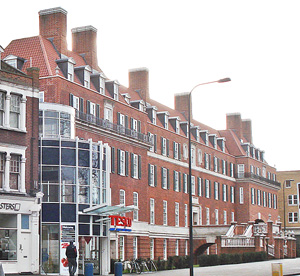
The facade on South Side - the Tesco drum is on the north side of the former Hospital building.

The building is now divided into a Tesco supermarket and an apartment block known as The Latitude at No. 130 Clapham Common South Side.
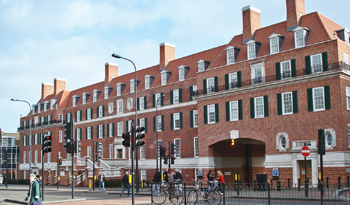
The building from the west.
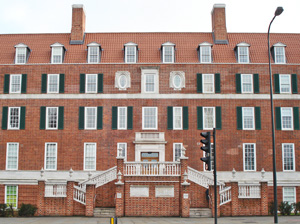
The main entrance with the commemorative stones set in the front wall of the external stairway.
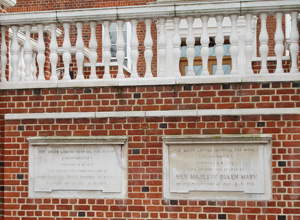
The commemorative stones set in the wall.

The foundation stone laid by the Princess Louise, Duchess of Argyll in 1913.
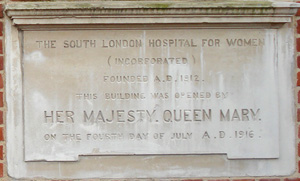
The stone commemorating the opening of the Hospital by Queen Mary in 1916.

The site of the first Out-Patients Department at Nos. 88 and 90 Newington Causeway has been completely redeveloped.
References (Accessed 5th March 2016)
(Author unstated) 1913 The South London Hospital for Women. British Journal of Nursing, 5th July, 13.
Boyd J, Hicks E, Louden M 1984 South London Hospital for Women. British Medical Journal 288, 74.
Castlereagh E 1914 The South London Hospital for Women. British Medical Journal 1 (2787), 1213.
Elston MA 2001 Run by Women, (mainly) for Women. Medical Women's Hospitals in Britain, 1866-1948. In: Hardy A, Conrad L (eds) Women and Modern Medicine, pp 73-105. Amsterdam, Rodopi.
http://discovery.nationalarchives.gov.uk
http://hansard.millbanksystems.com
http://landmark.lambeth.gov.uk (1)
http://landmark.lambeth.gov.uk (2)
http://landmark.lambeth.gov.uk (3)
http://landmark.lambeth.gov.uk (4)
http://landmark.lambeth.gov.uk (5)
http://landmark.lambeth.gov.uk (6)
http://moderngov.lambeth.gov.uk
http://wellcomeimages.org
https://en.wikipedia.org
https://rosannerabinowitz.wordpress.com
www.aim25.ac.uk
www.derelictlondon.com
www.geograph.org.uk
www.ihbc.org.uk
www.londonremembers.com
www.nationalgalleries.org
www.southlondon-today.co.uk